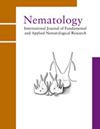伊利诺伊州卡罗莱纳单核线虫成虫携带的松材线虫初始数量的频率分布与日本交流棒线虫的频率分布
IF 1.2
4区 生物学
Q2 ZOOLOGY
引用次数: 0
摘要
松材线虫(PWN)是松材线虫病的病原体,主要由单孢属的神经酰胺成虫传播。据信,它于20世纪从北美传入日本,并于1999年入侵西欧。线虫一直在破坏入侵地区的松林,因为当地的松树物种很容易受到感染。这项研究检测了美国伊利诺伊州的个别卡罗莱纳M.carolinensis成虫在从死亡的樟子松和P.strobus树上出现后立即携带的PWN数量(初始PWN负荷)。将数据与日本约80年后从死亡的T.thunbergii树上出现的M.alternatus成虫的初始PWN负载进行了比较。当零膨胀负二项式模型被拟合到初始PWN负载时,它提供了三个结果。首先,PWN在PWN-M中的向量之间表现出聚集分布。carolinensis-P。sylvestris或P.strobus系统和PWN-M。交流发电机。日本的通贝里制度。第二,三种疾病系统之间初始PWN负荷的频率分布没有差异。第三,初始PWN负荷随着木材中越冬PWN密度或成虫体重的增加而增加,而随着媒介出现日期的增加而减少。因此,在日本,初始PWN负荷的频率分布没有表现出进化变化,并且初始PWN负载被认为是由环境因素和条件决定的。本文章由计算机程序翻译,如有差异,请以英文原文为准。
Frequency distribution of the initial number of Bursaphelenchus xylophilus carried by adult Monochamus carolinensis in Illinois, with reference to that by M. alternatus in Japan
The pine wood nematode (PWN), Bursaphelenchus xylophilus, is the causative agent of pine wilt disease and is transmitted primarily by cerambycid adults of the genus Monochamus. It is believed to have been introduced into Japan from North America in the 1900s and confirmed to have invaded western Europe in 1999. The nematode has been devastating pine forests in invaded areas because the native pine species are susceptible. This study examined the number of PWN carried by individual M. carolinensis adults (initial PWN load) immediately after emerging from dead Pinus sylvestris and P. strobus trees in Illinois, USA. The data were compared with the initial PWN load on M. alternatus adults emerging from dead P. thunbergii trees in Japan ca 80 years after the PWN invasion. When the zero-inflated negative binomial model was fitted to the initial PWN loads it provided three results. First, the PWN exhibited clumped distributions among vectors in the PWN-M. carolinensis-P. sylvestris or P. strobus system in Illinois and the PWN-M. alternatus-P. thunbergii system in Japan. Second, there was no difference in the frequency distribution of the initial PWN load between the three disease systems. Third, the initial PWN load increased as the overwintering PWN density in wood or the adult body mass increased, whereas it decreased as the emergence date of vectors increased. Consequently, the frequency distribution of initial PWN load exhibited no evolutionary change in Japan and the initial PWN load was considered to be determined by environmental factors and conditions.
求助全文
通过发布文献求助,成功后即可免费获取论文全文。
去求助
来源期刊

Nematology
生物-动物学
CiteScore
2.60
自引率
33.30%
发文量
67
审稿时长
3 months
期刊介绍:
Nematology is an international journal for the publication of all aspects of nematological research (with the exception of vertebrate parasitology), from molecular biology to field studies. Papers on nematode parasites of arthropods, and on soil free-living nematodes, and on interactions of these and other organisms, are particularly welcome. Research on fresh water and marine nematodes is also considered when the observations are of more general interest.
Nematology publishes full research papers, short communications, Forum articles (which permit an author to express a view on current or fundamental subjects), perspectives on nematology, and reviews of books and other media.
 求助内容:
求助内容: 应助结果提醒方式:
应助结果提醒方式:


